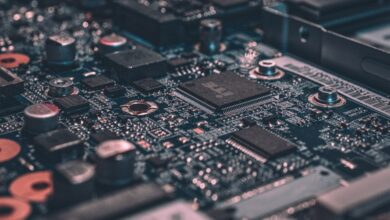Robotics in Healthcare: Assisting Surgeons and Caregivers

Robotic technology has revolutionized various industries, and the field of healthcare is no exception. In recent years, robotics has emerged as a valuable tool in assisting surgeons and caregivers, enhancing their capabilities and improving patient outcomes. Imagine a future where robots work side by side with medical professionals, seamlessly complementing their skills and expanding the possibilities of healthcare.
When it comes to surgery, precision is of utmost importance. Robotic surgical systems, such as the da Vinci Surgical System, have become increasingly popular. With its robotic arms and high-definition cameras, this advanced technology allows surgeons to perform complex procedures with enhanced dexterity and accuracy. The surgeon sits at a console, controlling the robotic arms, which mimic their hand movements in real-time. This level of precision reduces the risk of human error and enables minimally invasive surgeries, leading to faster recovery times and reduced complications for patients.
Moreover, robots are not limited to the operating room alone; they also play a crucial role in supporting caregivers. In eldercare facilities, robots can assist with various tasks, such as lifting and transferring patients, monitoring vital signs, and providing reminders for medication schedules. These robotic companions alleviate some of the physical strain on caregivers, enabling them to focus on delivering quality care and building meaningful relationships with their patients. Furthermore, robots can offer emotional support to patients by engaging in simple conversations or providing entertainment, helping to enhance their overall well-being.
The integration of robotics in healthcare raises exciting possibilities for the future. As technology continues to advance, we can expect even more sophisticated robots capable of performing intricate procedures autonomously, under the guidance of skilled surgeons. Additionally, advancements in artificial intelligence and machine learning enable robots to learn from vast amounts of medical data, assisting in diagnosis and treatment planning.
Robotics has proven to be a game-changer in healthcare, empowering surgeons and caregivers alike. From enhancing surgical precision to supporting daily caregiving tasks, robots are revolutionizing the way we approach patient care. As this exciting field continues to evolve, the collaboration between humans and robots will undoubtedly lead to better healthcare outcomes and improved quality of life for patients around the world.
Revolutionizing Healthcare: How Robotics is Transforming Surgical Procedures and Patient Care

Robots have taken the healthcare industry by storm, revolutionizing surgical procedures and transforming patient care. It’s a remarkable development that has left many in awe of the incredible advancements we are witnessing. These cutting-edge robotic technologies have paved the way for more precise, efficient, and minimally invasive surgeries, ultimately improving outcomes and enhancing the overall patient experience.
Imagine a scenario where a surgeon can operate on a patient with utmost precision through tiny incisions, using miniature robotic arms controlled by their skilled hands. This level of accuracy, facilitated by robotics, reduces the margin of error, resulting in better surgical outcomes and faster recovery times. With robotic-assisted surgery, surgeons can navigate complex anatomical structures with enhanced dexterity, providing a level of precision that was previously unimaginable.
But it’s not just during the surgery itself that robots make a difference. They also contribute to post-operative care and rehabilitation. For instance, robotic exoskeletons can aid patients in regaining mobility and strength after musculoskeletal injuries or strokes. These wearable devices provide support, assistance, and feedback to patients, allowing them to regain control over their movements and accelerate their recovery process.
Moreover, the integration of artificial intelligence (AI) into robotic systems has opened up even more possibilities. AI algorithms enable robots to analyze vast amounts of medical data, assisting healthcare professionals in diagnosis and treatment planning. These intelligent robots can quickly identify patterns, make predictions, and offer personalized recommendations based on individual patient data. As a result, healthcare providers can deliver more targeted and effective treatments, tailored specifically to each patient’s unique needs.
Robotic Surgeons take the Center Stage: Enhancing Precision and Efficiency in the Operating Room
Have you ever imagined a surgeon with a robotic assistant by their side, seamlessly performing intricate surgical procedures? Well, welcome to the future of medicine, where robotic surgeons are taking the center stage and revolutionizing the way surgeries are performed. With their ability to enhance precision and efficiency in the operating room, these robotic marvels are changing the face of modern healthcare.

Imagine a tiny, dexterous machine assisting skilled surgeons as they navigate through complex surgeries. Robotic surgeons bring a new level of accuracy to the table, allowing for precise movements that human hands alone could never achieve. With their advanced sensors and real-time imaging capabilities, these robots provide surgeons with detailed and magnified views of the surgical site, enabling them to make informed decisions with unparalleled precision.
Not only do robotic surgeons offer enhanced precision, but they also contribute to increased efficiency in the operating room. Time is of the essence during surgeries, and any delay or error can have serious consequences. Robotic systems minimize the risk of human error by following pre-programmed instructions, ensuring consistent and reliable performance. This allows surgeons to focus on critical decisions while the robot handles repetitive tasks, leading to reduced procedure times and improved patient outcomes.
One of the key advantages of robotic surgeons is their ability to perform minimally invasive procedures. Unlike traditional open surgeries that require large incisions, robotic-assisted surgeries involve small incisions through which the robot’s arms and instruments are inserted. These smaller incisions result in less post-operative pain, reduced scarring, and quicker recovery times for patients. Moreover, the robot’s flexibility and range of motion surpass those of human hands, enabling it to reach difficult-to-access areas with ease.
The integration of robotic surgeons in the operating room is a testament to the incredible advancements in medical technology. As these robotic miracles continue to evolve, we can expect even greater precision, improved capabilities, and expanded applications. From cardiac surgeries to urological procedures, robotic surgeons are here to stay, revolutionizing the field of surgery one procedure at a time.

Robotic surgeons have taken center stage in the operating room, enhancing precision and efficiency like never before. With their remarkable ability to provide surgeons with unprecedented accuracy, minimize human error, and enable minimally invasive procedures, these futuristic machines are making waves in the world of healthcare. As technology continues to advance, we can only anticipate further breakthroughs and an even brighter future for robotic surgeons. So, brace yourself for a new era of surgical excellence, where man and machine work hand in hand to save lives and redefine what’s possible in the operating room.
From Sci-Fi to Reality: How Robotics is Reshaping the Future of Healthcare
In a world where technology continues to advance at an astonishing pace, one area that is experiencing remarkable transformation is healthcare. Thanks to the rapid development of robotics, what was once considered science fiction is now becoming a reality. The integration of robotics in healthcare is revolutionizing the way medical procedures are performed and patient care is delivered.
Imagine a future where surgical procedures are carried out with utmost precision and accuracy. That future is already here. Robotic surgical systems, such as the da Vinci Surgical System, have made their mark in operating rooms around the world. These sophisticated machines, controlled by skilled surgeons, offer improved dexterity, enhanced visualization, and reduced invasiveness. With robotic assistance, surgeons can perform complex procedures through smaller incisions, resulting in reduced scarring, faster recovery times, and better outcomes for patients.
But it’s not just in the operating room where robotics is making a difference. Robots are also being used in rehabilitation settings to aid patients in their recovery process. Take exoskeletons, for example. These wearable robotic devices can assist individuals with impaired mobility to regain their ability to walk. By providing support and guidance, exoskeletons enable patients to rebuild strength and coordination, offering them newfound independence and improving their overall quality of life.

Another area where robotics is reshaping healthcare is in the field of patient care and assistance. Robots are being employed as companions for the elderly or individuals with disabilities, providing social interaction, reminders for medication, and assistance with daily tasks. These robotic companions are designed to be intuitive and empathetic, adapting to the needs and preferences of the users they serve. They alleviate loneliness and improve mental well-being, fostering a sense of companionship and support.
The future of healthcare lies in the integration of robotics, bringing together human expertise and technological advancements. As robots continue to evolve, we can expect even greater levels of precision, efficiency, and effectiveness in medical procedures. From surgical interventions to rehabilitation and patient care, robotics is transforming the healthcare landscape, enhancing outcomes, and improving the lives of patients worldwide.
The future is now, where science fiction becomes reality. Embrace the power of robotics in healthcare, and together we can shape a healthier and brighter future for all.
Unlocking New Possibilities: How Robots are Empowering Caregivers in the Healthcare Industry
In today’s ever-evolving world, technology has paved the way for groundbreaking advancements, and the healthcare industry is no exception. One such innovation that continues to amaze and impact the field is the use of robots as caregivers. Yes, you heard it right! Robots are now playing a crucial role in empowering caregivers and revolutionizing patient care.
Imagine a future where caring for the sick and elderly is not just limited to human hands. Robots are stepping into this realm, equipped with advanced capabilities to assist and support healthcare professionals. They are the new companions, working alongside caregivers to provide unparalleled care and improve the quality of life for patients.
Robots offer a range of services that benefit both patients and caregivers. For instance, they can help with basic tasks like lifting and transferring patients, reducing the risk of injury for both the caregiver and the patient. These robotic assistants can also remind patients to take their medication, monitor vital signs, and assist in physical therapy exercises, ensuring proper adherence to treatment plans.
But it doesn’t stop there. Robots are also capable of detecting potential hazards in a healthcare setting. With their sensors and cameras, they can identify spills, obstacles, or even unauthorized access, contributing to a safer environment for patients and staff alike. Moreover, their ability to collect and analyze large amounts of data enables caregivers to make informed decisions and provide personalized care based on individual needs.

The integration of robots in healthcare facilities is transforming the patient experience. These mechanical marvels provide emotional support by offering companionship and alleviating feelings of loneliness. Through interactive interfaces and intelligent algorithms, robots can engage in conversations, play games, and even provide entertainment, creating a sense of connection and belonging for patients.
As the old saying goes, “necessity is the mother of invention.” The shortage of healthcare professionals in many parts of the world has driven the development of robots as caregivers. By bridging the gap between supply and demand, robots ensure that patients receive the attention and care they deserve, even in resource-limited settings.
The integration of robots as caregivers in the healthcare industry is unlocking new possibilities and transforming the way we provide care. With their advanced capabilities, they assist and empower caregivers, augmenting their skills and enabling them to focus on critical tasks. From assisting with daily activities to enhancing patient safety and emotional well-being, robots are revolutionizing the healthcare landscape, bringing us closer to a future where compassionate care is accessible to all.




